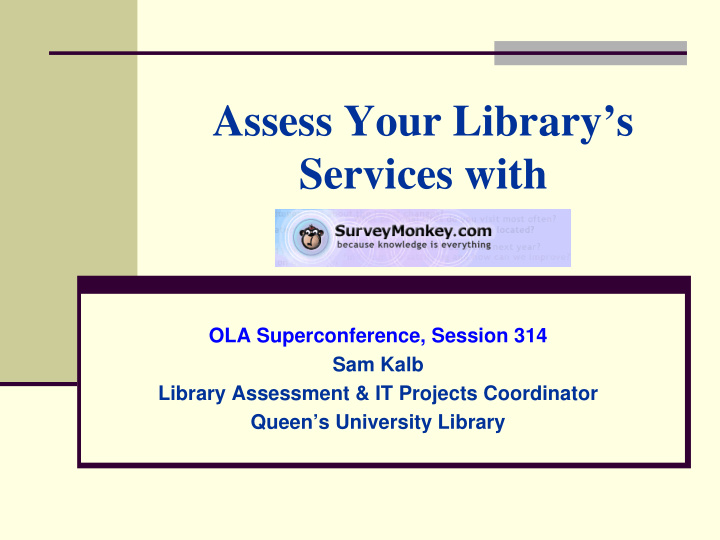



Assess Your Library’s Services with OLA Superconference, Session 314 Sam Kalb Library Assessment & IT Projects Coordinator Queen’s University Library
Outline � Survey Methodology & Design � Building Web Based Surveys � Analyzing Survey Results � Conclusions and Questions
Doing surveys easily & inexpensively Goal with
SurveyMonkey Costs � A professional subscription = $19.95 USD/month (or only $200.00 USD/year) � There are no long-term contracts, and you can cancel at any time. � No limits � Access to advanced features � necessary for any effective survey necessary for any effective survey �
Research Ethics Review � All research institutions have ethics review and approval requirements for research studies involving human subjects. � Queen’s GREB - any research project involving human subjects, whether funded or not, must receive ethics approval prior to the start of the project. � Tri-Council (CIHR, NSERC, SSHRC) exempts from such review "quality assurance studies, performance reviews or testing within normal educational requirements…" (TCPS, article 1.1[d]) Queen's Office of Research Services Human Ethics Review Boards http://www.queensu.ca/vpr/policies/committee.html
Sampling - factors � Medium used is important (email, forced web link, voluntary web link, personal interview, etc. Major factor in rate of response � Include entire population if small � Representativeness more important than overall sample size.
Sampling Methods � Random sampling. All members have equal chance to be measured. � Proportional and stratified random sampling. Each group being assessed is represented in the same proportion as the total population, e.g. 40% male, 60% female, etc. � Convenience sampling. Easiest but potentially most biased, e.g. students in a library on Tuesday between 2 and 5 pm.
Questions - Common Mistakes Lack of sufficient pre-testing � Bias � Unclear, jargon-based queries � Too many questions (esp. self-administered surveys) � Too many open-ended questions
Questionnaire Design � Survey introduction or preliminary page (esp. important in meeting GREB requirements) � Well-organized � Grab their attention � Easy to follow directions
SurveyMonkey Home page
SurveyMonkey Survey Manager
Starting a New Survey
Survey Design
Editing Survey Title & Page links
Telling Respondents About the Survey
Survey Question Types � Single choice � Multiple choice � Matrix/rating scales � Open-ended http://www.surveymonkey.com/help/HelpFrame.asp?P=QuestionOverview.asp
Question Type - One Answer (Vertical)
Question Type – Multiple Answers (Vertical)
Question Type – One Answer (Horizontal)
Question Type - Matrix
Options for Collection Responses
Survey Options - 1 � Collection options: � One response per computer � Multiple responses (shared or public computers) � Completion options: � Jump to a certain web site � Share results: � summary or detailed results publicly
Survey Options - 2 � Survey Limits � Maximum - stop after x no. of responses � Cut-off date & time � Survey Security � Password restriction � IP address restriction (only users from a certain web domain can enter) � Suppress IP address from displaying in results
Survey Results Analysis � Real time review � Filtering � Download to spreadsheet or database
Statistical Assessment - Definition Statistics are inferences inferences drawn from a sample sample population population Useful statistics are valid valid inferences drawn from Useful a representative representative sample population
Factors in evaluating online surveys � Self-reporting of responses – did respondent answer key questions (e.g. demographics) � Bias (questions & answers) � Accuracy of opinions � Beware of false links (do A & B really add up to C?) Do students with big feet really spell better? Do students with big feet really spell better?
SurveyMonkey & Survey Planning � Can use SurveyMonkey as both a record of past Library surveys and a resource to help staff preparing new surveys to: � avoid inadvertent duplication of past surveys � ensure that particualr data has not already been collected � avoid oversurveying a targeted group � offer a collection of questions reflecting sound survey methodology
Thank You Questions? Links: SurveyMonkey: http://www.surveymonkey.com/ OLA 2007 Presentation: http://hdl.handle.net/1974/285
Recommend
More recommend